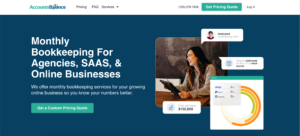
Ready to learn SAAS accounting basics for your SAAS business?
You’ve come to the right place.
My name is Connor Gillivan. I’m a 10+ year Entrepreneur and currently own and operate 3 B2B businesses online.
In 2019, I exited my business, FreeUp, after scaling it to 8 figures in yearly revenue.
I’ve seen the ups and downs of how accounting and bookkeeping can impact your business.
In this article, I want to help you understand SAAS accounting basics so you don’t run into the same issues I have in the past.
Here’s what we’ll cover:
- How Is SAAS Accounting Different?
- Lesson #1: Accrual vs Cash Basis Accounting
- Lesson #2: Don’t Intermingle Personal & Business Expenses
- Lesson #3: Key SAAS Financial Metrics
- Lesson #4: Best SAAS Accounting Software
- Lesson #5: Getting Your SAAS Books Completed Monthly
- Lesson #6: How to Make End of Year Taxes Easy
- Lesson #7: Common SAAS Accounting Mistakes to Avoid
How Is SAAS Accounting Different?
SaaS accounting differs from traditional accounting in a few key ways.
1. Firstly, revenue recognition is crucial in SaaS accounting. Unlike traditional businesses that may recognize revenue at the time of sale, SaaS companies typically recognize revenue over the life of the subscription. This means that revenue may be recognized over a period of months or even years, which requires careful tracking and reporting.
2. Secondly, SaaS accounting also requires a deep understanding of the metrics that drive the business. Metrics like customer acquisition cost (CAC), customer lifetime value (CLV), and monthly recurring revenue (MRR) are critical to tracking the health and growth of a SaaS company. These metrics require consistent and accurate tracking, which is where good bookkeeping comes into play.
Thirdly, SaaS accounting involves managing a complex web of expenses, including hosting costs, salaries and wages, software subscriptions, and more. Keeping track of these expenses and categorizing them correctly is crucial for accurate financial reporting and tax compliance.
Lesson #1: Accrual vs Cash Basis Accounting
As a SaaS entrepreneur, it’s important to understand the difference between accrual and cash basis accounting. While cash basis accounting may be simpler, accrual basis accounting provides a more accurate picture of your company’s financial health.
Here’s a breakdown of the two methods:
1. Cash Basis Accounting: With cash basis accounting, revenue is recorded when cash is received and expenses are recorded when cash is paid out. This method is straightforward and easy to understand, but it may not give an accurate picture of your company’s financial health since revenue may not be recognized until payment is received.
2. Accrual Basis Accounting: With accrual basis accounting, revenue is recognized when it is earned, regardless of when payment is received. Likewise, expenses are recognized when they are incurred, regardless of when payment is made. This method provides a more accurate picture of your company’s financial health since it takes into account revenue and expenses that have been earned or incurred, even if payment has not yet been made.
For SaaS companies, accrual basis accounting is often the preferred method since it provides a more accurate representation of revenue recognition over the life of a subscription. With accrual basis accounting, you can recognize revenue as soon as the customer subscribes, rather than waiting until payment is received.
Lesson #2: Don’t Intermingle Personal & Business Expenses

It’s important to keep your personal and business finances separate.
Here are some reasons why you should avoid intermingling personal and business expenses:
- Inaccurate Financial Reporting: If you mix personal and business expenses, it becomes difficult to determine your company’s actual revenue and expenses. This can make it challenging to create accurate financial statements, which can impact your ability to make informed business decisions.
- Legal Issues: If you mix personal and business expenses, you may be opening yourself up to legal issues. For example, if you’re sued, it may be difficult to prove which expenses were business-related and which were personal. This can impact your liability and potentially put your personal assets at risk.
- Tax Compliance Problems: If you mix personal and business expenses, you may have difficulty separating which expenses are deductible and which are not. This can cause tax compliance problems and potentially trigger an audit by the IRS.
To avoid these problems, it’s important to keep personal and business expenses separate.
How to do it: This means having separate bank accounts and credit cards for your business and personal expenses, as well as maintaining accurate records of all business expenses.
Lesson #3: Key SAAS Financial Metrics
Key SaaS financial metrics can help you track the health of your business, identify areas for improvement, and measure progress towards your goals.
Here are some of the most important SaaS financial metrics to track:
- Monthly Recurring Revenue (MRR): This metric measures the predictable monthly revenue generated by your customers. It is a key indicator of your company’s growth potential and can help you identify trends and changes in revenue over time.
- Customer Acquisition Cost (CAC): This metric measures the total cost of acquiring a new customer, including marketing and sales expenses. It is essential to understand CAC to determine the lifetime value of a customer and to ensure that your customer acquisition strategies are cost-effective.
- Churn Rate: This metric measures the rate at which customers are leaving your business. It is a critical metric for SaaS companies since customer retention is essential for long-term success. By tracking churn rate, you can identify areas for improvement in your product or customer service and take action to reduce customer turnover.
- Gross Margins: This metric measures the difference between your revenue and the cost of goods sold (COGS). It is a key indicator of your company’s profitability and can help you make informed decisions about pricing and cost management.
Lesson #4: Best SAAS Accounting Software

Here are some of the best SaaS accounting software options to consider:
- QuickBooks Online: QuickBooks Online is a cloud-based accounting software that is easy to use and affordable. It offers features such as invoicing, expense tracking, and financial reporting, making it a great choice for small and mid-sized SaaS companies.
- Xero: Xero is another popular cloud-based accounting software that offers a wide range of features, including invoicing, inventory tracking, and payroll management. It also integrates with many third-party apps, making it a flexible and customizable option for SaaS companies.
- FreshBooks: FreshBooks is a cloud-based accounting software that is designed specifically for small businesses and freelancers. It offers features such as time tracking, invoicing, and expense management, making it a great option for SaaS entrepreneurs who are just starting out.
- NetSuite: NetSuite is a more robust accounting software that is designed for larger SaaS companies. It offers features such as financial management, order management, and inventory tracking, making it a comprehensive solution for businesses that need more advanced functionality.
Lesson #5: Getting Your SAAS Books Completed Monthly
One of the most critical aspects of financial management is completing your books on a monthly basis.
This involves reconciling your bank accounts, recording transactions, and preparing financial statements.
Here are some tips for completing your SaaS books monthly:
- Schedule time each month: Set aside dedicated time each month to focus on your financial management tasks. This could be a few hours each week or a full day each month, depending on the size and complexity of your business.
- Use accounting software: Utilize accounting software such as QuickBooks Online, Xero, or FreshBooks to streamline your bookkeeping tasks and automate processes such as bank reconciliation and financial statement preparation.
- Keep receipts and records organized: Keep all receipts, invoices, and other financial records organized and easily accessible. This will make it easier to record transactions and reconcile your accounts each month.
- Reconcile bank accounts: Reconcile your bank accounts each month to ensure that all transactions have been recorded accurately and that there are no discrepancies between your bank statements and your accounting software.
- Prepare financial statements: Use your accounting software to prepare financial statements such as profit and loss statements and balance sheets each month. These statements can provide valuable insights into your company’s financial health and help you make informed decisions about future growth and investments.
- Outsource your bookkeeping: If you don’t want to do the bookkeeping yourself, you can outsource it to a bookkeeping service like AccountsBalance or hire a freelance Bookkeeper that understands SAAS businesses.
Lesson #6: How to Make End of Year Taxes Easy

Preparing for end-of-year taxes can be a daunting task.
However, with proper planning and organization, you can make the process much more manageable and stress-free.
Here are some tips for making end-of-year taxes easy:
- Keep accurate records: Keeping accurate and up-to-date financial records throughout the year will make tax time much easier. Be sure to keep receipts, invoices, and other financial documents organized and easily accessible.
- Review tax regulations: Stay up-to-date on tax regulations and changes that may impact your business. Consider hiring a tax professional to help you navigate complex tax laws and ensure compliance.
- Maximize deductions: Take advantage of all deductions and credits that your business is eligible for. This includes deductions for expenses such as office supplies, equipment, and travel expenses.
- Plan ahead: Start preparing for end-of-year taxes well in advance. Create a tax planning strategy and timeline to ensure that you have all the necessary information and documentation when it comes time to file.
- Utilize accounting software: Use accounting software such as QuickBooks Online, Xero, or FreshBooks to track expenses and generate financial reports. This will make it easier to identify deductions and prepare financial statements for tax purposes.
- Hire a professional: Consider hiring a tax professional to assist with end-of-year tax preparation. An experienced accountant can help ensure that your taxes are filed accurately and on time, while also helping you maximize deductions and minimize your tax liability.
Lesson #7: Common SAAS Accounting Mistakes to Avoid
Here are some common SaaS accounting mistakes to avoid:
- Failing to separate business and personal expenses: Mixing personal and business expenses can lead to inaccurate financial records, which can make it difficult to track your company’s financial health.
- Not reconciling bank accounts regularly: Failing to reconcile your bank accounts regularly can result in inaccurate financial statements and can make it harder to spot errors or discrepancies.
- Not tracking revenue and expenses separately: Tracking revenue and expenses separately is essential for accurate financial reporting and analysis. Failing to do so can make it harder to identify trends or areas for improvement.
- Not keeping up with accounts receivable and payable: Failing to stay on top of accounts receivable and payable can lead to cash flow issues and can impact your ability to pay bills or invest in growth opportunities.
- Failing to plan for taxes: Failing to plan for taxes can result in unexpected tax bills or penalties. It’s important to plan ahead and work with a tax professional to ensure compliance and minimize your tax liability.
- Not utilizing accounting software: Manual bookkeeping can be time-consuming and error-prone. Utilizing accounting software can streamline your financial management processes and make it easier to generate accurate financial reports.
- Not seeking professional advice: Accounting can be complex, and it’s important to seek professional advice when necessary. Consider hiring an accountant or SAAS bookkeeper to help guide your financial decisions and ensure compliance with tax regulations.
What Is AccountsBalance?

AccountsBalance is a monthly bookkeeping service specialized for agencies & SAAS companies.
We take monthly bookkeeping off your plate and deliver you your financial statements by the 15th or 20th of each month.
You’ll have your Profit and Loss Statement, Balance Sheet, and Cash Flow Statement ready for analysis each month so you and your business partners can make better business decisions.
Interested in learning more? Schedule a call with our CEO, Nathan Hirsch.
And here’s some free resources:
In Summary
You now have the SAAS accounting basics to succeed with your business.
Tl;dr:
- Lesson #1: Accrual vs Cash Basis Accounting
- Lesson #2: Don’t Intermingle Personal & Business Expenses
- Lesson #3: Key SAAS Financial Metrics
- Lesson #4: Best SAAS Accounting Software
- Lesson #5: Getting Your SAAS Books Completed Monthly
- Lesson #6: How to Make End of Year Taxes Easy
- Lesson #7: Common SAAS Accounting Mistakes to Avoid
Learn these 7 lessons and set up proper accounting and bookkeeping processes.
This will set you up for success so you don’t have to worry about your accounting.
I promise you’ll be happy that you did.
If you still have any questions, reach out to us at [email protected].
Cheers!









